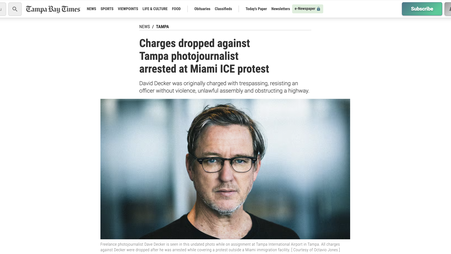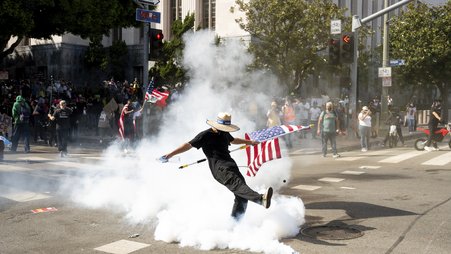
In August of last year, Freedom of the Press Foundation — along with Committee to Protect Journalists and two dozen advocacy groups — launched the U.S. Press Freedom Tracker, a first-of-its-kind project that aimed to document and count every press freedom violation in the United States.
In just six months, we have now logged over 125 press freedom incidents — ranging from a congressman body-slamming a journalist to protesters smashing reporters’ cameras.We have documented chilling statements, including three separate occasions when the president of the United States called for the firing of journalists who criticized him. We have reported on all kinds of journalists — from independent Youtube livestreamers to correspondents for CNN and Fox News — who have been arrested, jailed, assaulted, subpoenaed, and pressured while doing their jobs.
With just a few days to go until the one year anniversary of the inauguration of Donald Trump, an avowed critic of press freedom protections, here’s what we learned about violations of press freedom in the United States in 2017:
In 2017, 33 journalists were arrested while doing their jobs. (One journalist was arrested twice, making a total of 34 arrests.) Of all the the arrests in 2017, 88% occurred at protests and rallies.
The single largest source of journalist arrests was St. Louis, Missouri, where the police responded to protests against the acquittal of Jason Stockley — a white former police officer who shot a black man — with kettles and mass arrests that swept up 10 journalists.
Many of the journalists who were arrested described violent and aggressive police tactics. Take Jon Ziegler, an independent journalist who frequently livestreams protests on the Youtube channel RebZ.tv, who said that police pepper sprayed him while he was pinned on the ground.
“I was drenched in spray” Ziegler told the Freedom of the Press Foundation. “I remember my tripod looking like it had rained on it. … I start feeling jabs in my back. All of a sudden, I feel a foot or a knee on the back of my head just pushing it into the concrete and grinding it into the concrete.”
Two documentary filmmakers, Drew and Jennifer Burbridge, sued the City of St. Louis over their treatment by police.
Significant amounts of journalists were also arrested while covering protests against President Donald Trump’s inauguration in Washington, D.C. and while covering demonstrations at the Standing Rock reservation.
Nine journalists were arrested at the inauguration protests, accounting for 26% of the total number of the 2017 arrests. These reporters were all initially charged with felonies, an unusual and very concerning development. In most cases, journalists arrested while covering protests are charged with vague misdemeanors like trespassing or obstruction, but the reporters arrested on inauguration day were charged under Washington, D.C.’s draconian felony rioting statute. Following a public outcry, federal prosecutors dropped charges against most of the reporters arrested that day — but not all of them.
The U.S. government insisted on prosecuting independent photojournalist Alexei Wood and freelance reporter Aaron Cantú, and a grand jury indicted the journalists on eight separate felony counts. Wood went to trial in November, and a jury acquitted him on all counts. Cantú is scheduled to go to trial later this year.
Six journalists were arrested at Standing Rock in 2017, accounting for 18% of the total number of 2017 arrests. (Even more journalists were arrested in 2016, but they don’t count toward the 2017 count.) All of them were charged with misdemeanors, and prosecutors have refused to drop charges against all but one of them.
In all, eight journalists in the U.S. currently face criminal charges.
Some of those arrested had their equipment seized or searched by law enforcement. In total, the U.S. Press Freedom Tracker documented 15 instances of equipment search and seizure by authorities, which includes seizures following an arrest as well as seizures at a border stop.
Among the equipment seized: cameras and camera lenses, memory cards, mobile phones, laptops, notebooks, a monopod, an external microphone, even a bicycle.
In 2017, 43 journalists were physically attacked or had their equipment damaged while doing their jobs. (One journalist was attacked on multiple occasions, for a total of 44 attacks.) Many of these reporters were assaulted by violent protesters of varying political stripes, but others were assaulted by law enforcement officers. In two cases, reporters were assaulted by politicians!
On May 2, Alaska state senator David Wilson slapped Alaska Dispatch News reporter Nathaniel Herz, as Herz tried to interview him.
Then on May 24, Montana congressman Greg Gianforte body-slammed Guardian U.S. reporter Ben Jacobs, as Jacobs tried to interview him. Gianforte originally tried to blame Jacobs for the assault, but later apologized to him and eventually pleaded guilty to misdemeanor assault. He was sentenced to community service and a small fine. (He also donated $50,000 to the Committee to Protect Journalists, which was used to fund the U.S. Press Freedom Tracker, as part of the terms of a civil settlement he reached with Jacobs.)
But assaults by politicians only account for 4.5% of the total number of physical attacks in 2017. Including attacks by police officers, 70% of the total number of physical attacks against journalists in the U.S. occurred at protests and rallies.
Who was attacking all these journalists at protests? In five cases (19% of the attacks at protests and 11% of the total attacks), the assailants were law enforcement officers. But in sixteen cases, the assailants were protesters — either white nationalist protesters or anti-fascist protesters — who objected to a journalist’s reporting.
The U.S. Press Freedom Tracker also documented several other categories of press freedom violations, including chilling statements (many by Trump himself), subpoenas, leak prosecutions and more. You can search through all the data on our website. We encourage reporters to use the data for their own investigations.
While the First Amendment is a unique and powerful protection that virtually all other countries lack, the state of press freedom in the United States is increasingly perilous. It’s vital that we continue to monitor any and all attacks on journalists, and we plan on even more coverage in 2018.




